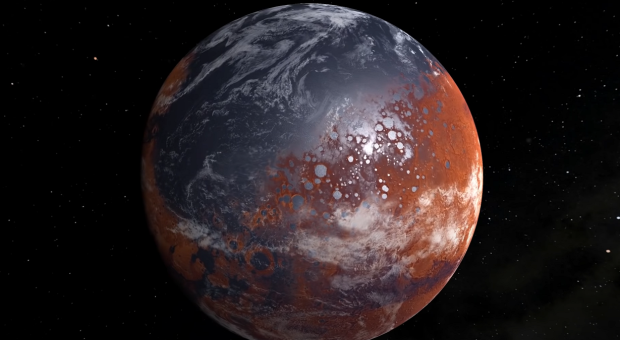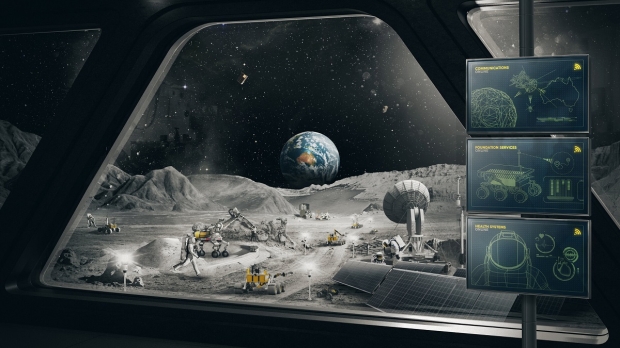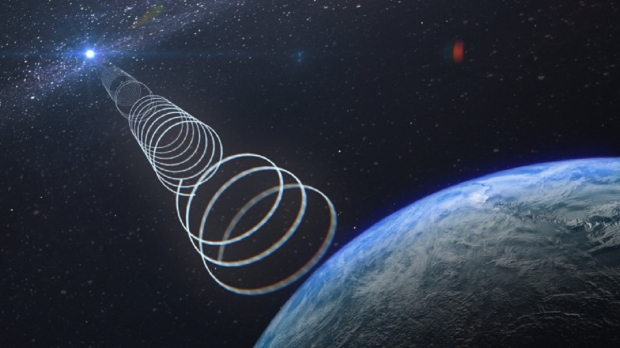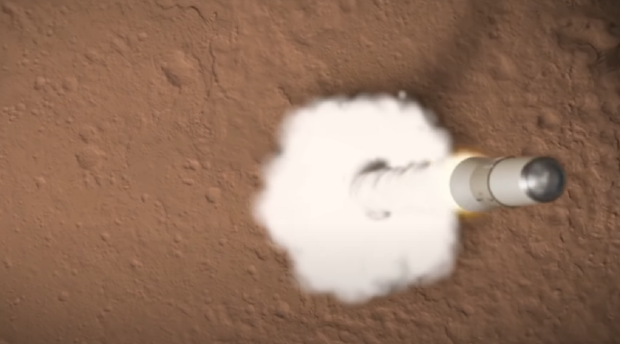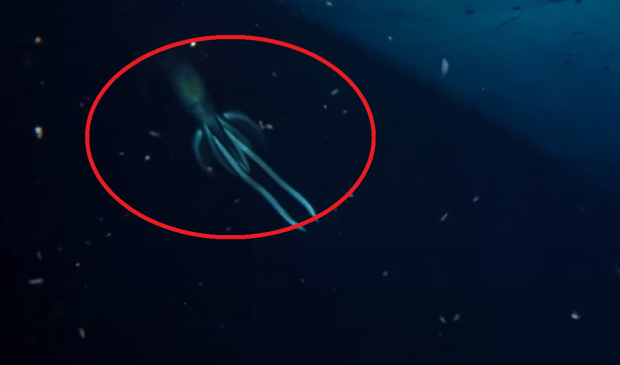Science, Space, Health & Robotics News - Page 262
NASA answers a big question, 'did Mars ever look like Earth?'
Why do NASA and other space agencies want to explore the barren wasteland that is Mars? Is it because the planet was once like Earth?
NASA has taken to its YouTube channel to post a new video that's a part of its "We Asked a NASA Scientist" series that is curated around answering some of the biggest questions the agency gets and some of the most popular questions about the universe. In this week's episode, NASA astrobiologist Dr. Becky McCauley Rench said that Mars did once look like Earth billions of years ago when our solar system was forming.
The NASA astrobiologist goes on to say that today when we look at Mars, we see a dry planet, but there is evidence of Mars once having lakes and streams. This news of Mars having a lake was recently confirmed with NASA's Perseverance rover that captured images of a delta in the Jezero Crater, more on that story can be found here. Dr. Rench continued to explain that studying the Red Planet allows researchers to understand more about Mars' past/future as well as Earth's past/future.
Continue reading: NASA answers a big question, 'did Mars ever look like Earth?' (full post)
NASA is planning to extract oxygen from the lunar surface with this
NASA has announced it has partnered with the Australian Space Agency to construct a new rover that will assist in sustaining human presence on the Moon.
The announcement comes from the Australian Space Agency who has agreed to construct a 44-pound semi-autonomous lunar rover that is scheduled to go to the Moon as early as 2026. The new rover will search for oxygen and be capable of collecting soil that contains oxides that oxygen will be extracted from using separate NASA equipment.
According to the announcement, the rover will be used to extract oxygen from the lunar surface, which will then be used to support a sustained presence of human activity on the Moon and eventually support future missions to Mars. Anthony Murfett, the deputy head of the Australian Space Agency, said that NASA was impressed with the technology that's currently being used to remotely control trucks that transport iron ore from 1,000 miles away. For more information on this story, check out this link here.
Continue reading: NASA is planning to extract oxygen from the lunar surface with this (full post)
Signals detected from galaxy core, 'we've never seen anything like it'
A mysterious radio signal has been detected by astronomers that "fit no currently understood pattern of variable radio source".
An international Ph.D. student in the School of Physics at the University of Sydney, Ziteng Wang, explained in a new study published in the Astrophysical Journal that mysterious radio signals were detected using CSIRO's ASKAP radio telescope that's located in Western Australia. The Ph.D. student pointed the radio telescope towards the center of the Milky Way galaxy, and found "The brightness of the object also varies dramatically, by a factor of 100, and the signal switches on and off apparently at random. We've never seen anything like it."
The discovery of these unusual radio signals has suggested that it could be a new class of stellar object. Over the course of nine months, throughout 2020, more observations were conducted with international researchers, and in total, the astronomers were able to detect six radio signals from the source. Additionally, it should be noted that when the astronomers attempted to view the source of the radio signals in visible light, they saw nothing.
Continue reading: Signals detected from galaxy core, 'we've never seen anything like it' (full post)
Mystery signals from distant stars detected, possible 'hidden planets'
Researchers have used the world's most powerful radio antenna to detect signals from distant stars that suggest undiscovered planets are orbiting them.
The researcher was published in Nature Astronomy and details the use of the world's most powerful radio telescope dubbed LOFAR, or Low Frequency Array. Researcher at the University of Queensland, Dr. Benjamin Pope, along with other researchers from the Dutch national observatory ASTRON, discovered signals from nineteen distant red dwarf stars, four of the signals are best explained by "planets orbiting them", according to Dr. Pope.
Dr. Joseph Callingham at Leiden University and ASTRON, and lead author of the discovery, explained that the radio wave detection could be from the interaction between the red dwarf star and an orbiting planet, but this isn't 100% confirmed. However, Dr. Callingham says, "We can't be 100 percent sure that the four stars we think have planets are indeed planet hosts, but we can say that a planet-star interaction is the best explanation for what we're seeing."
Continue reading: Mystery signals from distant stars detected, possible 'hidden planets' (full post)
There is one thing that William Shatner doesn't want to see in space
If you happened to miss the news, William Shatner would be taking Blue Origin's New Shepard rocket to space very soon.
Shatner recently announced the news via Twitter, saying that he will be joining Blue Origin vice president of mission and flight operations and actor Audrey Powers on the mission. Originally, the launch for the mission was scheduled for October 12, but due to the bad weather conditions, Blue Origin announced the launch had to be pushed back by 24 hours.
In a video released by Blue Origin, Shatner said that he is very excited about the launch and that he plans to be looking out the window with his nose pressed up against it. In the same video, Shatner said that there is one thing he doesn't want to see, and that is gremlin looking back at him, which is a reference to the iconic 1963 episode of "The Twilight Zone" called "Nightmare at 20,000 Feet." During that episode, Shatner played a character on a flight to space that spots a gremlin on the wing of the plane.
Continue reading: There is one thing that William Shatner doesn't want to see in space (full post)
NASA is planning on returning extraterrestrial cargo back to Earth
NASA and the European Space Agency (ESA) are currently devising a plan to safely transport extraterrestrial cargo back to Earth.
NASA's Perseverance rover is collecting samples from the surface of Mars, and these samples will be stored on the rover until they are required to be transported back to Earth for analysis. This transportation process is no small feat and will require high levels of precision to pull off correctly and safely. The samples will be placed into sterilization storage containers that are sealed, preventing any contamination. The process of getting the samples back on Earth is a long one and will require several things to align correctly.
Perseverance is currently carrying Mars' samples, and when the time comes to send them back to Earth, the Mars rover will hand them over to a fetch rover that engineers are currently developing at NASA. This rover will then transport the samples to a lander that has a robotic arm that will place the samples into the head of a rocket. The rocket will then launch from the surface of Mars and transport the samples to an ESA orbiter that will prepare the samples for transportation back to Earth.
Continue reading: NASA is planning on returning extraterrestrial cargo back to Earth (full post)
Earth directly impacted by blast from the Sun, here's what happened
This week officials warned that Earth was going to get with large solar flare from the Sun, which could potentially affect satellites, internet connections, and more.
Officials at the US National Oceanic and Atmospheric Administration (NOAA) warned that a coronal magnetic ejection (CME) was on a direct collision course with Earth and was expected to arrive on October 12. NOAA warned that the effects of the CME would cause minor geomagnetic storms in Earth's atmosphere, which could result in auroras being seen in locations such as north of England and Northern Island.
The CME has impacted Earth, and officials are happy to report that everything went as anticipated. Solar wind speed increased by nearly 62 miles a second, and total interplanetary magnetic field (IMF) strength quickly elevated to over 15 nT. Additionally, NOAA states on its website that the CME arrival caused a G1-G2 geomagnetic storm which is categorized as "minor - moderate". The geomagnetic storm caused gorgeous auroras to be spotted in the sky. Those can be seen in the above video.
Continue reading: Earth directly impacted by blast from the Sun, here's what happened (full post)
'Larger than a human' mysterious sea creature captured on video
A team of marine biologists has been left baffled at the discovery of a giant sea creature as they were exploring a sunken ship.
The team at OceanX was investigating the sunken ship called "Pella", which sadly sunk 2,300 feet to the ocean floor in November 2011. According to the video post to the OceanX YouTube channel, the team of researchers sent their remotely operated vehicle (ROV) down to the ship to investigate the wreckage, and when observing the bow of the ship, a creature "larger than a human" did its own investigation of the ROV.
OceanX science program lead Mattie Rodrigue said, "I will never forget what happened next for as long as I live. All of a sudden, as we're looking at the bow of the shipwreck, this massive mysterious creature comes into view, takes a look at the ROV, and curls its entire body around the bow of the wreck." The researchers go on to say that they are yet to identify what the creature is, but suspect it's a species squid, which species exactly has yet to be confirmed, but the team is consulting with experts.
Continue reading: 'Larger than a human' mysterious sea creature captured on video (full post)
How much gravity can humans survive before our bones break?
Gravity is a phenomenon that humans will have to take into consideration before we decide to colonize a new world.
In layman's terms, gravity comes from the amount of mass an object has. More mass = a stronger gravitational field. An example of this would be comparing Earth's gravity to Mars, the Moon, or the Sun. Earth's standard gravity is 2.66 times that of Mars at 9.807 m/s squared. Mars is just 3.721 m/s squared. However, both of these figures are nothing compared to the Sun's gravity, that's about 27.9 times that of Earth at 274 m/s squared.
Measuring weight your weight on planets would yield different results as the mass of the planets would be different, and therefore, the gravity would be different. With all this now in mind, researchers have published a paper on the pre-print server arXiv that attempts to answer the question, "What is the maximum gravitational field humans can survive for long-term?" The researchers took into account factors such as extreme gravitational fields causing injuries to human bones.
Continue reading: How much gravity can humans survive before our bones break? (full post)
Officials warn Earth will get hit by an enormous solar flare very soon
Yesterday, officials warned that a blast from the Sun was heading directly to Earth, and now officials have updated the time of impact.
Originally, officials from the US National Oceanic and Atmospheric Administration (NOAA) said that an M-class solar flare (second largest classification) caused a coronal magnetic ejection (CME) of charged particles to erupt from the surface of the Sun. The solar wind (charged particles) was found to be directly on course with Earth, and officials estimated that it would impact Earth on October 10.
However, a new update from NOAA states that the CME will arrive around 12 pm on October 11 with "lingering effects persisting into October 12." So, what does this mean for humans? Dr Sangeetha Abdu Jyothi, from the University of California, Irvine and VMware Research, explained, "A Coronal Mass Ejection (CME) involves the emission of electrically charged matter and accompanying magnetic field into space. When it hits the Earth, it interacts with the Earth's magnetic field and produces Geomagnetically Induced Currents (GIC) on the crust."
Continue reading: Officials warn Earth will get hit by an enormous solar flare very soon (full post)


